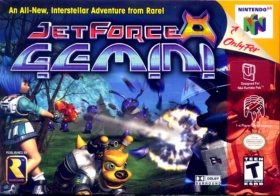
The Impact of Jet Force Gemini
Jet Force Gemini launched 20 years ago on 11th October 1999. Developed by Rare, well known for their more famous releases on the Nintendo 64 such as Banjo-Kazooie, Goldeneye, and Perfect Dark, Jet Force Gemini was a polarising game which brought a lot of features to the table, some say too many. The game definitely made an impact on the industry however, with its mistakes and triumphs influencing games as we know them today.

As the only surviving crew from a surprise attack on the legendary Jet Force, players must take on the role of one of three protagonists to stop an invading alien force before it reaches Earth. Even today most games only task you with playing as one protagonist, but Jet Force Gemini was one of the first to provide the option of more, each with their own distinct strengths and weaknesses.
For some players, choosing between characters became a problem, since the choice could make the following level easier, or much, much more difficult. With such a wide range of level types as well, it was almost impossible to know which character would fare best when selecting them. With two humans and a robotic dog to choose from, it’s possible that players were shooting themselves in the foot for the sake of playing as the dog most of the time.
Looking at games today, it’s easy to see that Jet Force Gemini has shown developers that characters can be wildly different from each other in their games, but also that the game as a whole shouldn’t be hindered by those differences.

Another reason that Jet Force Gemini was so polarising was the sheer amount of variety in gameplay it offered. Some levels were on-rails shooters, whilst others could be platformers, or run and gun missions. Coupled with a huge number of collectibles, as was standard for most Rare games, Jet Force Gemini was bloated in an unusual way. Part of the drive to include so many different features in the game was the desire to create something truly unique, but in the end it simply ended up being a game that didn’t quite know what it wanted to be.
Today it’s uncommon to see a developer try to squeeze as much into their game as Rare did with Jet Force Gemini. Instead, games have become more focussed over the years, offering just one or two core types of gameplay to players. The advantage to players is that newer games are a lot more polished because of this focus. PUBG, for example, is a phenomenal battle royale game, because it’s entirely dedicated to providing an uncompromised experience in that genre. Likewise, every game from Paradox Interactive is a fantastic strategy title, because that’s where they’ve doubled down.

However, for all that made Jet Force Gemini a marmite title among N64 players, it had a number of concepts that have since been used in much larger games. Passive co-op, for example, was possible in the game, with one player controlling the chosen protagonist and one controlling a shoulder-mounted turret. More recently, passive co-op has been used in Super Mario Galaxy, with additional players collecting stars with a secondary Wii Remote. The Dark Pictures Anthology: Man of Medan also has passive co-op. Players are able to influence each other’s games with the decisions they make, though here it has evolved to also allow players to hinder each other through those same decisions.
The concept of completing a game might have evolved since Jet Force Gemini, but it’s debatable whether you could say the same about the process of achieving 100% completion.. In Jet Force Gemini players are told they must rescue as many natives as possible, these form one type of collectible. Players are able to accidentally kill these natives, which is a big problem when they get to the end of the game. Unfortunately for some Jet Force Gemini can only be completed, and show an ending, once every single native has been saved. This rule makes me think of the restrictions that Dark Souls players put on themselves, stating that they haven’t truly finished the game unless they’ve beaten it without ever summoning in another player for assistance.
What’s even more confusing about Jet Force Gemini, is that there’s a lot more to collect than just natives. The heads of enemies can drop off and be collected, gems throughout the levels need to be hoovered up, a plethora of upgrades are waiting to be found, and a small number of secrets can be discovered. Today developers might use the same amount of collectible items in a game, but they’ll reward the player with an exclusive ending for nabbing them all, as opposed to withholding that feeling of completion until an unclear objective has been accomplished.

Overall Jet Force Gemini was met with mainly positive reviews, though everyone had their own points to criticise. However you feel about it, the game’s impact on what we play today is undeniable. Ultimately the developers had an idea that they wanted to achieve with Jet Force Gemini, and they would say that they did just that. The game might seem like a mess at times, but it showed developers that they can still produce something great without compromising on their vision, which is probably the biggest impact Jet Force Gemini has had.








COMMENTS